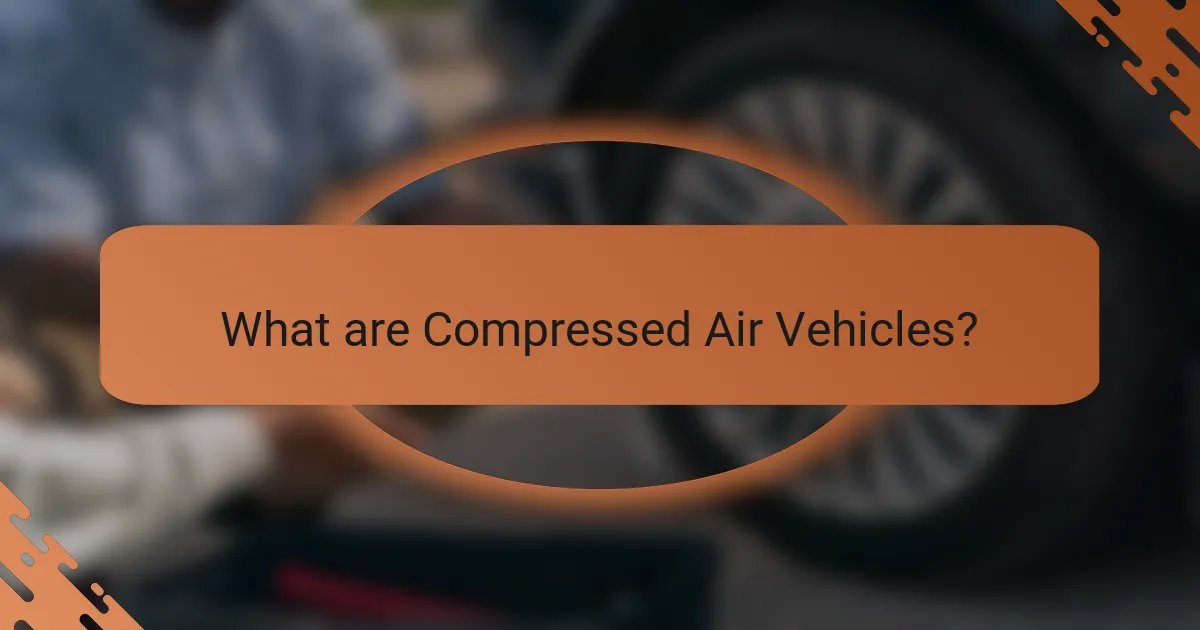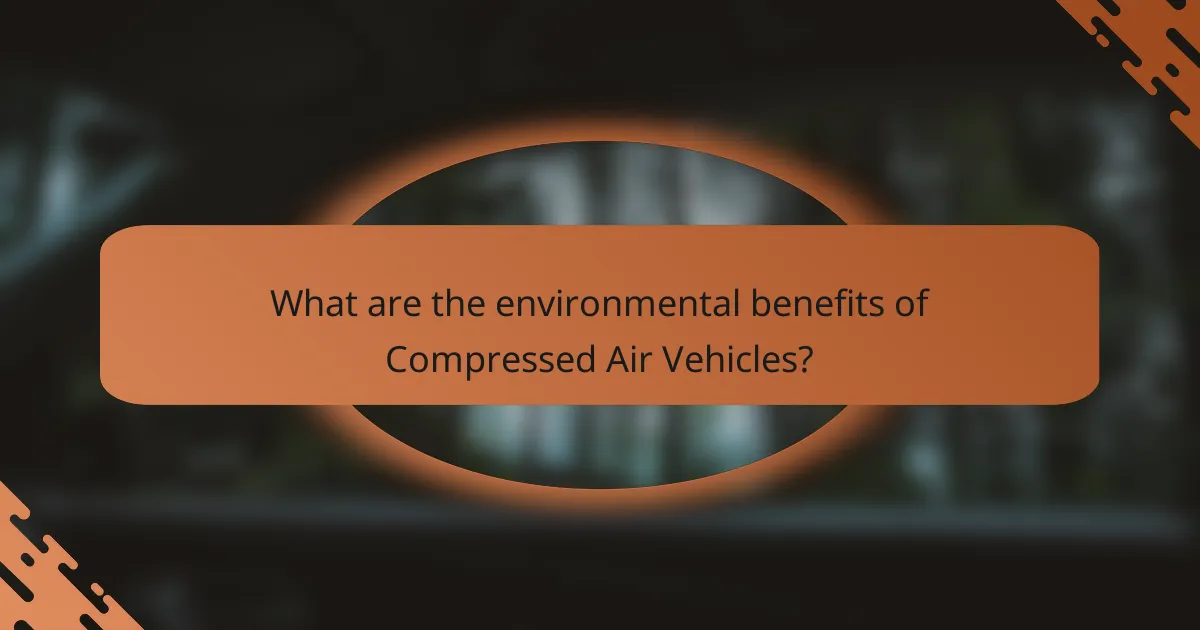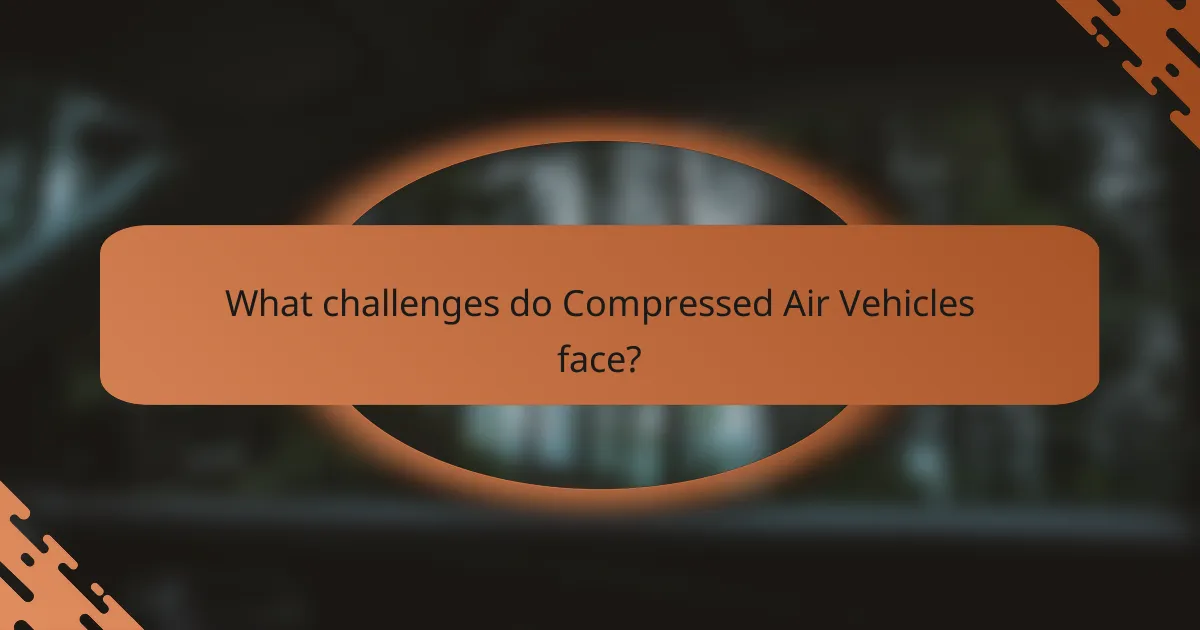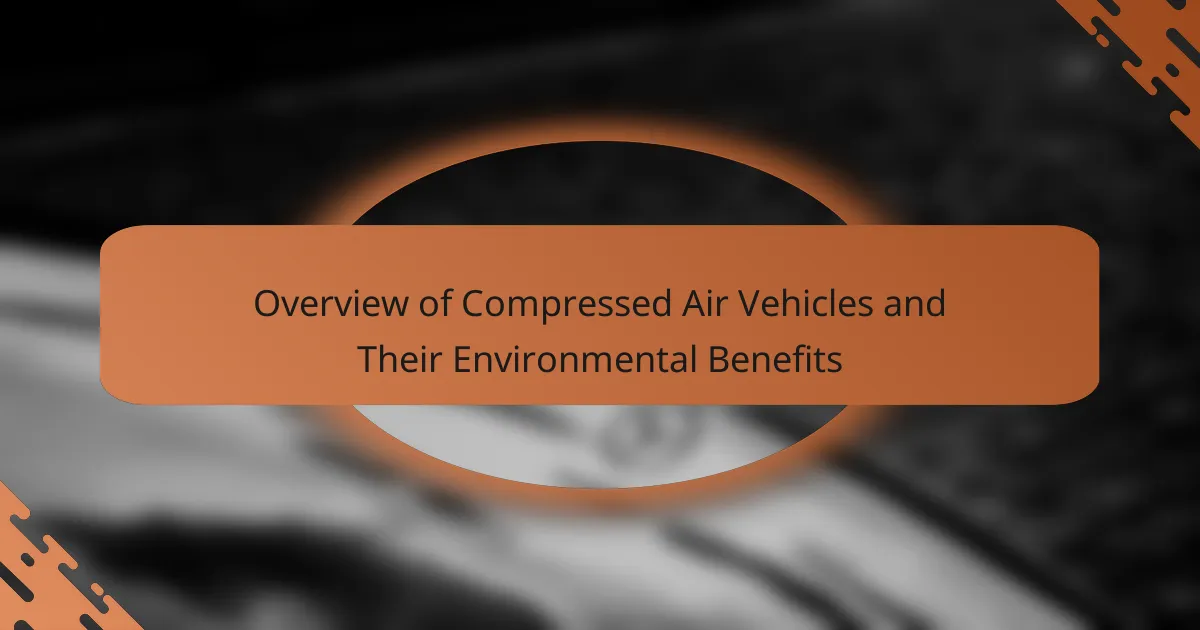Compressed Air Vehicles (CAVs) are innovative transportation solutions powered primarily by compressed air, offering a zero-emission alternative to traditional fossil fuel vehicles. These vehicles utilize stored compressed air to drive pistons or turbines, significantly reducing greenhouse gas emissions and contributing to cleaner urban air quality. Despite their environmental benefits, CAVs face challenges including limited range, low energy density, and insufficient refueling infrastructure. Additionally, the technology’s manufacturing and maintenance costs can be higher than conventional vehicles, impacting their market adoption. This article provides an overview of CAVs, highlighting their ecological advantages and the obstacles hindering their widespread use.

What are Compressed Air Vehicles?
Compressed air vehicles are vehicles powered by compressed air as their primary energy source. These vehicles use compressed air stored in tanks to drive pistons or turbines. The technology aims to provide an alternative to traditional fuel sources. Compressed air vehicles produce zero emissions during operation. They can potentially reduce reliance on fossil fuels. The concept has been explored since the 19th century. Recent advancements have improved efficiency and performance. Research indicates that compressed air vehicles can contribute to cleaner urban transport solutions.
How do Compressed Air Vehicles operate?
Compressed air vehicles operate by utilizing compressed air as a source of energy for propulsion. These vehicles store air in high-pressure tanks. When the air is released, it expands and drives pistons or turbines. This process converts the stored energy into kinetic energy. Compressed air engines can be designed to work in various configurations. They can either use a reciprocating mechanism or a rotary design. The efficiency of compressed air vehicles can vary based on design and application. Studies indicate that they produce zero emissions during operation, contributing to environmental benefits.
What are the key components of a Compressed Air Vehicle?
The key components of a Compressed Air Vehicle (CAV) include the air storage tank, compressor, pneumatic motor, and control system. The air storage tank holds compressed air, which powers the vehicle. The compressor is responsible for compressing air and filling the storage tank. The pneumatic motor converts compressed air into mechanical energy to drive the vehicle. The control system manages the flow of air to optimize performance. Each component plays a crucial role in the functionality and efficiency of the vehicle.
How is compressed air stored and utilized in these vehicles?
Compressed air in vehicles is stored in high-pressure tanks. These tanks are typically made of strong materials like carbon fiber or steel. The compressed air is generated by an onboard compressor. This compressor compresses ambient air and fills the storage tanks.
Utilization of compressed air occurs through a system of valves and regulators. These components control the release of air to the vehicle’s engine. The released air drives pistons or turbines, converting air pressure into mechanical energy.
This energy powers the vehicle’s movement. Compressed air systems are efficient, producing zero emissions during operation. They provide a sustainable alternative to traditional fuel-powered engines.
What types of Compressed Air Vehicles exist?
Compressed air vehicles include several types such as compressed air cars, buses, and motorcycles. Compressed air cars utilize air stored at high pressure to power an engine. These vehicles are designed for urban commuting and short distances. Compressed air buses are larger vehicles that serve public transportation needs. They aim to reduce emissions in city environments. Compressed air motorcycles are another variant, providing a compact and efficient mode of transport. These vehicles are still in the experimental phase but show promise for future development. Each type showcases the potential of compressed air technology in reducing reliance on fossil fuels.
What are the differences between personal and commercial Compressed Air Vehicles?
Personal Compressed Air Vehicles (CAVs) are designed for individual use, while commercial CAVs are intended for business applications. Personal CAVs typically have lower capacity and range, suitable for short trips. They often prioritize user comfort and convenience. In contrast, commercial CAVs are built for efficiency and durability, handling larger loads and longer distances. Commercial models may include features for cargo transport and fleet management. Regulatory requirements also differ; commercial vehicles must comply with stricter safety and emissions standards. Personal CAVs focus more on user-friendliness and affordability. These distinctions shape their design, functionality, and intended market.
How do various designs impact performance and efficiency?
Various designs of compressed air vehicles significantly impact their performance and efficiency. Aerodynamic shapes reduce drag, enhancing speed and energy conservation. Lightweight materials improve acceleration and reduce energy consumption. Engine design influences power output and fuel efficiency. For instance, optimized valve configurations can increase airflow, boosting performance. Additionally, the arrangement of storage tanks affects weight distribution, influencing handling and stability. Research shows that vehicles designed with these principles can achieve 20-30% better efficiency compared to traditional models. Overall, thoughtful design choices are critical for maximizing the effectiveness of compressed air vehicles.

What are the environmental benefits of Compressed Air Vehicles?
Compressed Air Vehicles (CAVs) offer significant environmental benefits. They produce zero tailpipe emissions, contributing to cleaner air quality. CAVs rely on compressed air as their power source, reducing dependency on fossil fuels. This shift helps lower greenhouse gas emissions. Additionally, CAVs can operate with lower noise levels compared to traditional vehicles. This reduction in noise pollution enhances urban living conditions. The use of renewable energy sources for air compression further amplifies their environmental advantages. Studies indicate that CAVs can lead to a substantial decrease in urban smog levels. Overall, CAVs represent a sustainable transportation alternative with multiple ecological benefits.
How do Compressed Air Vehicles reduce greenhouse gas emissions?
Compressed Air Vehicles reduce greenhouse gas emissions by using compressed air as a source of propulsion instead of fossil fuels. This technology eliminates the combustion process, which is a primary contributor to greenhouse gas emissions. Compressed air vehicles operate by storing air in high-pressure tanks and releasing it to drive pistons or turbines. As a result, they produce zero tailpipe emissions during operation. According to a study by the International Energy Agency, transitioning to compressed air systems can significantly lower urban air pollution levels. Additionally, these vehicles can utilize renewable energy sources for air compression, further minimizing their environmental impact.
What is the impact of using compressed air instead of fossil fuels?
Using compressed air instead of fossil fuels significantly reduces greenhouse gas emissions. Compressed air vehicles produce zero tailpipe emissions during operation. This shift helps mitigate climate change by lowering carbon dioxide levels in the atmosphere. Additionally, compressed air is a renewable energy source when generated from sustainable practices. Fossil fuels, in contrast, contribute to air pollution and health problems. According to the U.S. Environmental Protection Agency, transportation accounts for nearly 29% of total greenhouse gas emissions. By adopting compressed air technology, we can decrease reliance on fossil fuels and promote cleaner air.
How do Compressed Air Vehicles contribute to cleaner air quality?
Compressed Air Vehicles (CAVs) contribute to cleaner air quality by producing zero tailpipe emissions. Unlike conventional vehicles, CAVs operate using compressed air as fuel. This eliminates harmful pollutants such as nitrogen oxides and particulate matter. Studies show that transitioning to CAVs can significantly reduce urban air pollution levels. For instance, a report by the International Energy Agency highlights that adopting alternative fuel vehicles can decrease greenhouse gas emissions. Additionally, CAVs promote energy efficiency, further supporting cleaner air initiatives. This makes them a viable solution for improving urban air quality.
What role do Compressed Air Vehicles play in sustainable transportation?
Compressed Air Vehicles (CAVs) play a significant role in sustainable transportation by offering an alternative to fossil fuel-powered vehicles. CAVs utilize compressed air as a primary energy source, resulting in zero tailpipe emissions during operation. This technology reduces dependence on traditional fuels, contributing to lower greenhouse gas emissions. Studies indicate that CAVs can significantly decrease urban air pollution levels. Additionally, they promote energy efficiency by converting air pressure into kinetic energy effectively. The operational costs of CAVs are generally lower than those of gasoline or diesel vehicles, enhancing their economic viability. Furthermore, the potential for using renewable energy sources to compress air further supports sustainability goals.
How can Compressed Air Vehicles support renewable energy integration?
Compressed Air Vehicles (CAVs) can support renewable energy integration by utilizing stored compressed air for propulsion. This technology allows for the efficient use of excess renewable energy generated during peak production times. CAVs can be charged using renewable sources like wind or solar power, converting this energy into compressed air. This process helps to balance energy supply and demand, especially when renewable generation exceeds consumption. According to a study by the International Renewable Energy Agency, integrating CAVs can enhance grid stability and reduce reliance on fossil fuels. Thus, CAVs play a crucial role in promoting a sustainable energy ecosystem.
What are the potential long-term benefits for urban mobility?
The potential long-term benefits for urban mobility include reduced traffic congestion and improved air quality. Compressed air vehicles can operate with zero emissions, contributing to cleaner urban environments. Enhanced public transportation systems can lead to increased accessibility for residents. This accessibility can stimulate economic growth in urban areas. Additionally, improved mobility options can promote healthier lifestyles by encouraging walking and cycling. Studies indicate that cities adopting sustainable mobility solutions experience a decrease in vehicle-related accidents. Long-term investments in urban mobility infrastructure can result in significant cost savings for municipalities. Overall, these benefits foster more sustainable and livable urban spaces.

What challenges do Compressed Air Vehicles face?
Compressed Air Vehicles face several significant challenges. One primary issue is the limited range of these vehicles. Compressed air storage systems typically provide less energy density compared to conventional fuels. This results in shorter driving distances before refueling is necessary. Additionally, the efficiency of converting compressed air back into kinetic energy is relatively low. This inefficiency can lead to increased energy consumption during operation.
Another challenge is the infrastructure for refueling. Currently, there are insufficient refueling stations for compressed air vehicles. This lack of infrastructure limits the practicality of these vehicles for widespread use. Furthermore, the technology for storing and compressing air is still developing. Innovations are needed to enhance the performance and safety of compressed air systems.
Lastly, the cost of manufacturing and maintaining compressed air vehicles can be higher than traditional vehicles. This can deter potential consumers and manufacturers from investing in this technology. Overall, these challenges hinder the adoption of compressed air vehicles in the automotive market.
What are the technological limitations of Compressed Air Vehicles?
Compressed Air Vehicles (CAVs) face several technological limitations. One major limitation is their energy density, which is significantly lower than that of conventional fuels. This results in limited range and power output. CAVs typically require large tanks to store compressed air, which adds weight and complexity. The efficiency of converting compressed air back into mechanical energy is also low, often below 30%. Additionally, the infrastructure for refueling compressed air is not widely developed. Temperature fluctuations can affect performance, as compressed air can lose energy when expanding. These factors collectively hinder the practicality and adoption of CAVs in mainstream transportation.
How does energy efficiency compare to traditional vehicles?
Energy efficiency in compressed air vehicles significantly surpasses that of traditional vehicles. Compressed air vehicles convert stored air into kinetic energy more efficiently than internal combustion engines convert fuel. Studies indicate that compressed air vehicles can achieve energy efficiencies of up to 70%. In contrast, traditional gasoline or diesel vehicles typically operate at around 20% efficiency. This difference results in lower energy consumption and reduced greenhouse gas emissions for compressed air vehicles. Additionally, compressed air vehicles require less energy for maintenance and operation, further enhancing their overall efficiency.
What are the current research and development efforts addressing these challenges?
Current research and development efforts focus on improving the efficiency and performance of compressed air vehicles. Researchers are exploring advanced storage techniques to enhance energy density. Projects are underway to develop lightweight materials that reduce vehicle weight and improve energy efficiency. Innovations in compression technology aim to increase the effectiveness of air storage systems. Studies are also investigating hybrid systems that combine compressed air with other energy sources for better range and performance. Collaborations between universities and automotive companies are driving these advancements. For example, the University of California has partnered with several automotive firms to develop next-generation compressed air engines. These efforts aim to overcome current limitations and promote wider adoption of compressed air vehicles.
How can consumers effectively engage with Compressed Air Vehicles?
Consumers can effectively engage with compressed air vehicles by researching available models and understanding their features. They should evaluate the environmental benefits, such as reduced emissions and energy efficiency. Test driving different models can provide firsthand experience of performance and comfort. Joining forums or online communities can offer insights from current owners. Consumers should also stay informed about government incentives for purchasing eco-friendly vehicles. Attending expos or events focused on green technology can enhance knowledge and networking opportunities. Engaging with manufacturers directly can clarify any questions about maintenance and operation.
What should consumers consider when choosing a Compressed Air Vehicle?
Consumers should consider the vehicle’s range, efficiency, and refueling infrastructure. The range of a compressed air vehicle typically varies between models, impacting travel distance. Efficiency relates to how effectively the vehicle converts air pressure into motion. Refueling infrastructure is crucial, as access to air refueling stations can affect usability. Additionally, consumers should evaluate the vehicle’s environmental impact. Compressed air vehicles produce minimal emissions, contributing to cleaner air. Research indicates that these vehicles can significantly reduce carbon footprints compared to traditional fossil fuel vehicles. Finally, consumers should consider the initial cost and maintenance requirements, as these factors influence long-term ownership costs.
What are the best practices for maintaining Compressed Air Vehicles?
Regular inspection of compressed air vehicles is essential for optimal performance. Check the air tanks for leaks and ensure they are properly sealed. Monitor the pressure levels to maintain efficiency and prevent overloading. Clean and replace air filters regularly to ensure clean air intake. Inspect the vehicle’s components for wear and tear to prevent malfunctions. Ensure that the vehicle’s software is updated for optimal functionality. Follow the manufacturer’s maintenance schedule for specific guidelines. Document all maintenance activities for future reference and accountability.
Compressed air vehicles (CAVs) are innovative transportation solutions powered by compressed air, offering an alternative to traditional fuel sources. This article explores their operational mechanisms, key components, and types, including personal and commercial variants. It highlights the environmental benefits of CAVs, such as zero emissions and reduced greenhouse gas output, while also addressing challenges like limited range and infrastructure needs. Additionally, the article covers energy efficiency comparisons with conventional vehicles and ongoing research aimed at overcoming technological limitations.
